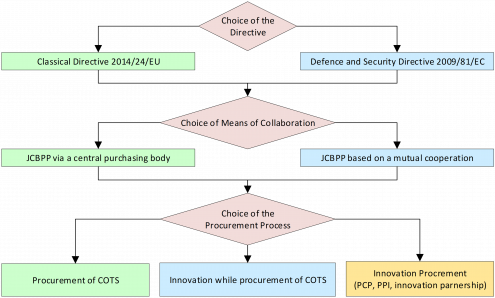Overview

In a collaboration with a CPB, the regulation of the Classical Directive might force CAs to prefer types of collaboration where the procurement procedure is conducted entirely by the CPB – a scenario most suited for COTS, but also where the desired innovation is achieved by giving a novel use to an otherwise non-innovative product.
In case of innovation procurement, collaboration agreements must be sufficiently flexible in order to accommodate the possibly changing scenarios in the course of the product development and rise of unforeseen circumstances.
Establish a timescale and agreeing on the organization of the three phases of procurement, specially to the preparatory phase.
Within the preparatory phase, CAs must pay attention, during the technical dialogue, to the need to refrain from engaging economic operators to an extent that might later cause these operators to be excluded from the procurement.
Some EU funded projects
CLOSEYE: The main aim of this project was to pursue the validation of innovative services applicable to the surveillance of the EU Maritime Borders in real operational environment. More information can be found on the following web-page
https://cordis.europa.eu/project/id/313184
EWISA: The project aimed at providing assessment of the management of illegal migration flows in the land border, through the increase of knowledge degree of operational situation and the enhancement of reaction capacity of the participating authorities responsible for land border security. More information can be found on the following web-page:
https://cordis.europa.eu/project/id/608385
EUCISE2020: The project aimed at achieving the pre-operational information sharing on sea-basins between the maritime authorities of the involved European States. More information can be found on the following web-page:
http://www.eucise2020.eu/
BROADWAY: The project (still ongoing) aims at enabling a pan-European broadband mobile system for PPDR, validated by sustainable test and evaluation capabilities. More information can be found on the following web-page:
https://www.broadway-info.eu/
SHUTTLE: The project (still ongoing) aims at developing a toolkit which will facilitate the analysis of microtraces collected in crime scenes. More information can be found on the following web-page:
https://www.shuttle-pcp.eu/
JCBPP in the security sector: where to start?
Pre-tender phase, in order to test solutions regarding:
- International representation competences & authorizations needed for Collaboration agreement
- Internal budgetary regulations
- Public interest sharing and joint unmet needs decision
- Conducting joint preliminary market consultations:
- can be described as a formalised dialogue between the CA and other entities (economic operators, suppliers or independent experts), aiming to obtain answers to the question of how the problems of the CA can be solved, or
- Art 40 Dir 2014/24/EU states that “in view of preparing the procurement and informing economic operators of their procurement plans and requirements”, CAs may, for example, seek or accept advice from independent experts or authorities or from market participants, that can may be used in the planning and conduct of the procurement procedure, provided that such advice does not have the effect of distorting competition and does not result in a violation of the principles of non-discrimination and transparency.
For further information regarding benefits for CAs and suppliers, how to conduct a PMC, steps and appropriate measures, please consult ![]() How to conduct a PMC
How to conduct a PMC
Tender phase:
- Law applicable to procurement procedure & to contract performance
- Awarding criteria definition
- Members of the competition jury
- Competence regarding contract monitoring and application of penalties
- In innovation procurement, what are the criteria for sharing risks? And how to manage “joint” IPR? How to avoid shifting too much (unreasonable) risk to the contractor?
Contract performance and assessment results
- Did the contractor released what was contracted?
- Did we contracted what we needed?
- If applicable, what happened?
What must be changed in a future JCBPP?
JCBPP and IP in the Security Sector
JCBPP and IP in the Security Sector
Joint Cross-Border Public Procurement (JCBPP)
Innovation Procurement (IP)
How to: Guide for JCBPP & IP
Ethics in procurement























